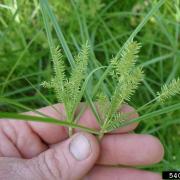Invasive Species: Cyperus entrerianus, Deeprooted Sedge
Deeprooted sedge is a wetland sedge that invades disturbed areas throughout the southeastern United States. It is a robust, up to 40 in. (102 cm) tall, grass-like plant with deeply set, thick rhizomes and dark purple to black leaf bases. The leaves are basal, glossy, and flat or V-shaped. The terminal inflorescence has 5 to 11 elongate rays ending in densely clustered spikelets. A large plant can produce one million viable seeds a year. Deeprooted sedge invades wet, disturbed areas such as highway ditches and field margins, where it can displace native vegetation. Construction, agricultural activities, and roadside mowing are spreading the seeds and dispersing this plant to new areas. Deeprooted sedge is native to South America and was accidentally introduced into the United States around 1990.
What are invasive species and why should we be concerned about them?
Taxonomy: Scientific and Common Names for This Species
Cyperales > Cyperaceae > Cyperus entrerianus Boeckl.
Synonym(s): woodrush flatsedge
Cyperus entrerianus – USDA PLANTS Profile
Distribution Maps
Deeprooted sedge – The reported distribution of this invasive species across the United States. (Source: Invasive Plant Atlas of the United States)
Up-to-the-minute distribution maps and why they are important
Reporting This Invasive Species
What is the best way and place to report the occurrence of an invasive species?
How to report an invasive species sighting to EDDMapS – Early Detection & Distribution Mapping System
EDDMapS – Report an invasive species to EDDMapS
County Extension Offices – Find your local Cooperative Extension office on this map provided by USDA
How to Identify
This invasive species can be identified by looking for the characteristics described in the paragraphs that follow.
Plant
It is a robust, up to 40 in. (102 cm) tall, grass-like plant with deeply set, thick rhizomes and dark purple to black leaf bases.
 |
 |
| Charles T. Bryson, USDA Agricultural Service, bugwood.org | Richard Carter, Valdosta State University, bugwood.org |
Foliage
The leaves are basal, glossy, and flat or V-shaped.
 |
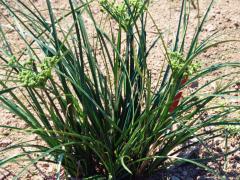 |
| Charles T. Bryson, USDA Agricultural Service, bugwood.org | Charles T. Bryson, USDA Agricultural Service, bugwood.org |
Flower
The terminal inflorescence has 5 to 11 elongate rays ending in densely clustered spikelets.
 |
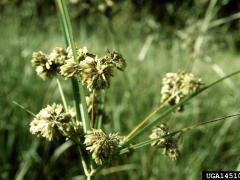 |
| Charles T. Bryson, USDA Agricultural Service, bugwood.org | Richard Carter, Valdosta State University, bugwood.org |
Fruit
A large plant can produce one million viable seeds a year. It also spreads by rhizomes and division of the plant.
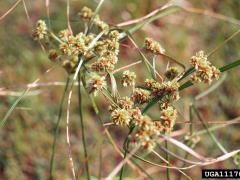 |
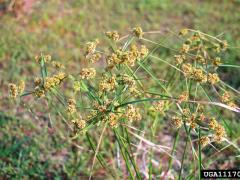 |
| Charles T. Bryson, USDA Agricultural Service, bugwood.org | Charles T. Bryson, USDA Agricultural Service, bugwood.org |
Native Species That Can Resemble Deeprooted Sedge
Cyperus erythrorhizos, redroot flatsedge – Images at invasive.org
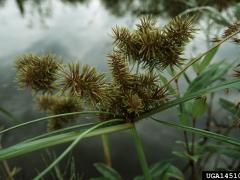 |
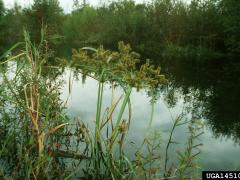 |
| Richard Carter, Valdosta State University, bugwood.org | Richard Carter, Valdosta State University, bugwood.org |
Cyperus odoratus, flatsedge – Images at invasive.org
|
|
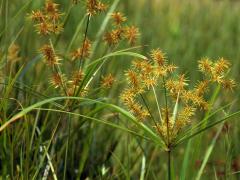 |
|
Graves Lovell, Alabama Department of |
James H. Miller & Ted Bodner, Southern Weed Science Society, bugwood.org |
Additional Images for Deeprooted Sedge
Deeprooted sedge – Images at Invasive.org
Additional Information, Biology, Control and Management Resources
Control and management recommendations vary according to individual circumstances. Location, habitat, weather, and a variety of other conditions are factors that help determine the best treatment choice. To find the safest and most effective treatment for your situation, consult your state’s land-grant institution. If you will use chemicals as part of the control process, always refer to the product label.
United States Land-Grant University System – Find your land-grant university’s college of agriculture, Cooperative Extension office, or other related partner on this map provided by USDA.
Deeprooted Sedge – An Overlooked Aggressive Weed in the Southeastern U.S. – Invasive Plants of the Eastern U.S.: Identification and Control
Control/Suppression of Deeprooted Sedge – Invasive Plants of the Eastern U.S.: Identification and Control
Invasives Database – TexasInvasives.org

